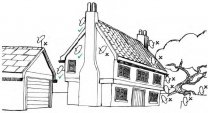Planning permission for satellite Dishes

Before you buy or rent an antenna, check whether you need planning permission, listed building consent, or permission from the landlord or owner. You are responsible for placing antennas in the appropriate position.
The planning permission and permitted development regimes for antenna are shown below, you can also view our good practice guidance on installing an antenna (which contains supplementary advice on installation).
Under the The Town and Country Planning (General Permitted Development) (England) Order 2015 (as amended), you have a general permission to install an antennas up to a specific size on property without the need for planning permission. This general permission depends on your house type and area. Your local planning authority can give you more advice.
The regime splits buildings up into four categories detailed on the following pages:
Glossary
Linear dimension - This means taking the measurement in a straight line, starting from the edge of the antenna to the opposite edge of the antenna. The measurement should only include the antenna itself and not any attachment needed to fix it to the wall or roof, or connect it up to your equipment.
Projecting feed element - In a dish antenna, the incoming signals are received by the dish which then ‘reflects’ the signal into a central ‘feed horn’. This is usually positioned at a short distance (a few inches) away from the dish and held in place by projecting arm or arms.
Cubic capacity - This means the volume (the amount of in 3 dimensions) occupied by an object using known method of measurement.
Flats
If you live in a flat, these limits refer to the building as a whole and not to each separate flat.
If the number of dishes or antennas installed on the building has already reached the maximum allowed, you will need planning permission for further installations.
In this case, you may want to discuss with other residents the possibility of a shared system.
Designated Areas
Designated areas are:
- conservation areas;
- National Parks;
- Areas of Outstanding Natural Beauty
- the Norfolk or Suffolk Broads.
- World Heritage Sites *
Listed Buildings
Some buildings are ‘listed’ because of their special historic or architectural interest. Your local planning department can tell you whether the building is ‘listed’. If you live in a ‘listed building’ and want to install an antenna on that building, you generally need to apply for ‘listed building consent’. This consent is different from planning permission. You need listed building consent for any antenna that affects the character or appearance of a listed building or its setting.
Related posts:
- Price of satellite dish
- Prime Focus satellite Dishes
- International satellite dish
- Pictures of satellite Dishes

 How to make squash How to remote control desktop using lan tricks Tricks for keeping marks off your nose when wearing sunglasses Quickbooks help how to enter tips…
How to make squash How to remote control desktop using lan tricks Tricks for keeping marks off your nose when wearing sunglasses Quickbooks help how to enter tips… As both J.D. Power and Associates and Consumer Reports have noted, satellite enjoys a superior customer service rating among its multichannel competitors. Sustaining…
As both J.D. Power and Associates and Consumer Reports have noted, satellite enjoys a superior customer service rating among its multichannel competitors. Sustaining… What does tin stand for Tips on how to breed better dragons in dragonvale Linus tech tips how to build a pc what does negative mean what is capital murders mean…
What does tin stand for Tips on how to breed better dragons in dragonvale Linus tech tips how to build a pc what does negative mean what is capital murders mean… Simply activate the receiver through an existing DISH account or subscribe to a new Pay-As-You-Go programming package. Pathway X2 can point to either Western or…
Simply activate the receiver through an existing DISH account or subscribe to a new Pay-As-You-Go programming package. Pathway X2 can point to either Western or… A Dish Network digital video recorder (DVR) is controlled by a specialized remote that is provided with it. The Dish Network remote uses a code that allows it to…
A Dish Network digital video recorder (DVR) is controlled by a specialized remote that is provided with it. The Dish Network remote uses a code that allows it to…